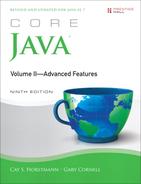Book Description
Fully updated to reflect Java SE 7 language changes, Core Java®, Volume II—Advanced Features, Ninth Edition, is the definitive guide to Java’s most powerful features for enterprise and desktop application development.
Designed for serious programmers, this reliable, unbiased, no-nonsense tutorial illuminates advanced Java language and library features with thoroughly tested code examples. As in previous editions, all code is easy to understand and displays modern best-practice solutions to the realworld challenges faced by professional developers.
Volume II quickly brings you up-to-speed on key Java SE 7 enhancements, ranging from the new file I/O API to improved concurrency utilities. All code examples are updated to reflect these enhancements. Complete descriptions of new language and platform features are highlighted and integrated with insightful explanations of advanced Java programming techniques. You’ll learn all you need to build robust production software with
Streams, files, and regular expressions
XML
Networking
Database programming facilities
JNDI/LDAP directory integration
Internationalization
Advanced Swing techniques
JavaBeans components
Web services
Advanced platform security features
Annotations
Distributed objects
Native methods, and more
For detailed coverage of fundamental Java SE 7 features, including objects, classes, inheritance, interfaces, reflection, events, exceptions, graphics, Swing, generics, collections, concurrency, and debugging, look for Core Java™, Volume I—Fundamentals, Ninth Edition (ISBN-13: 978-0-13-708189-9).
Table of Contents
- Title Page
- Copyright Page
- Contents
- Preface
- Acknowledgments
- Chapter 1. Streams and Files
- Chapter 2. XML
- Chapter 3. Networking
- Chapter 4. Database Programming
- Chapter 5. Internationalization
- Chapter 6. Advanced Swing
- Chapter 7. Advanced AWT
- 7.1. The Rendering Pipeline
- 7.2. Shapes
- 7.3. Areas
- 7.4. Strokes
- 7.5. Paint
- 7.6. Coordinate Transformations
- 7.7. Clipping
- 7.8. Transparency and Composition
- 7.9. Rendering Hints
- 7.10. Readers and Writers for Images
- 7.11. Image Manipulation
- 7.12. Printing
- 7.13. The Clipboard
- 7.14. Drag and Drop
- 7.15. Platform Integration
- Chapter 8. JavaBeans Components
- Chapter 9. Security
- Chapter 10. Scripting, Compiling, and Annotation Processing
- Chapter 11. Distributed Objects
- Chapter 12. Native Methods
- 12.1. Calling a C Function from a Java Program
- 12.2. Numeric Parameters and Return Values
- 12.3. String Parameters
- 12.4. Accessing Fields
- 12.5. Encoding Signatures
- 12.6. Calling Java Methods
- 12.7. Accessing Array Elements
- 12.8. Handling Errors
- 12.9. Using the Invocation API
- 12.10. A Complete Example: Accessing the Windows Registry
- Index
